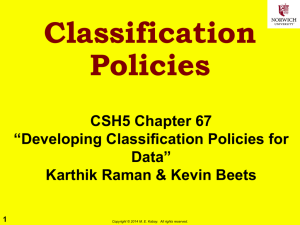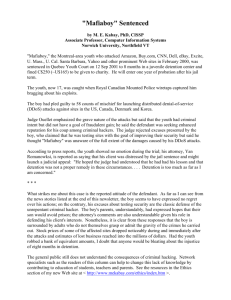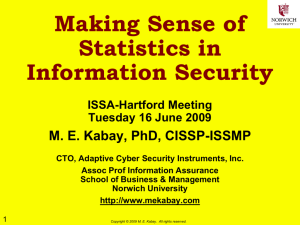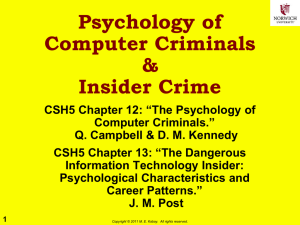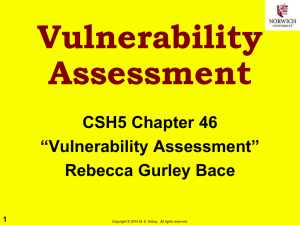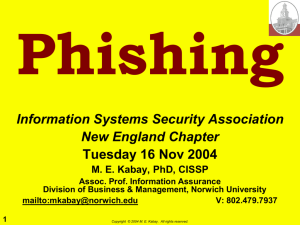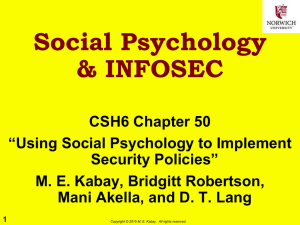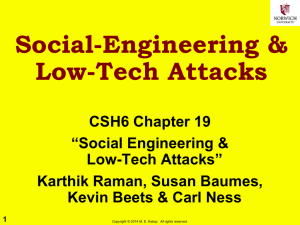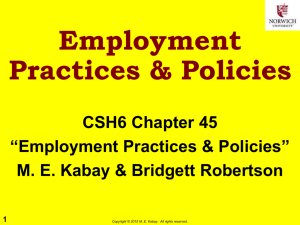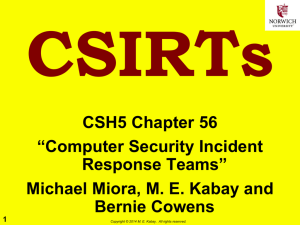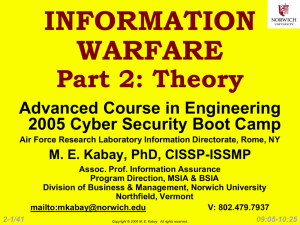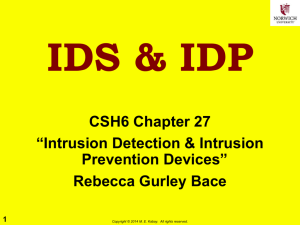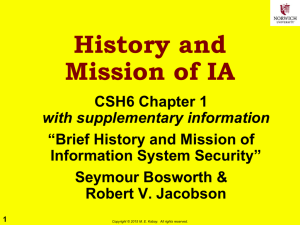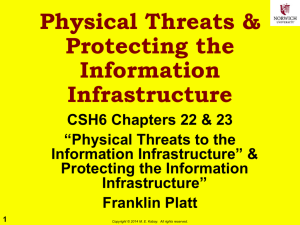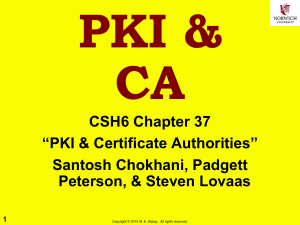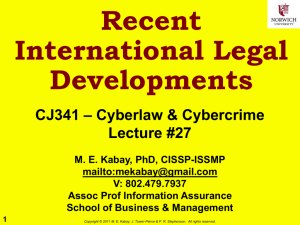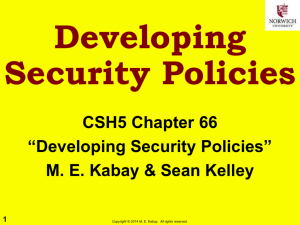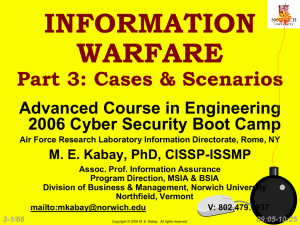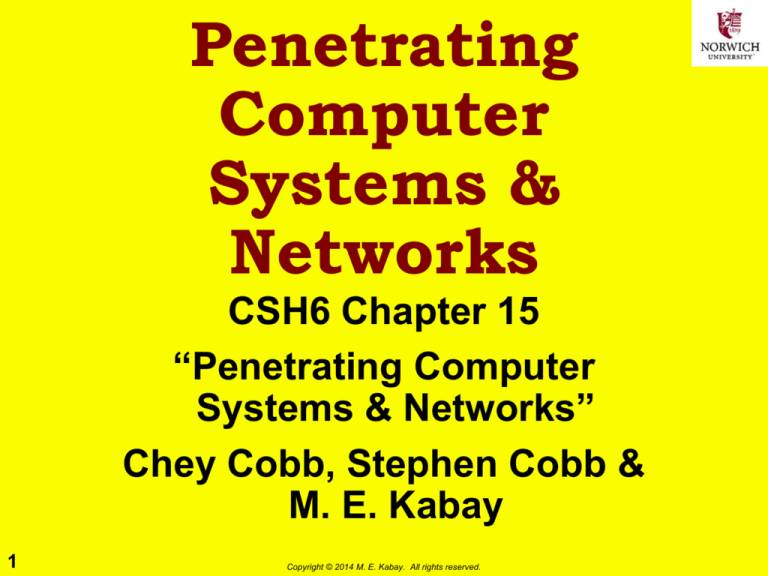
Penetrating
Computer
Systems &
Networks
CSH6 Chapter 15
“Penetrating Computer
Systems & Networks”
Chey Cobb, Stephen Cobb &
M. E. Kabay
1
Copyright © 2014 M. E. Kabay. All rights reserved.
Topics
CSH6 Chapter 15
“Penetrating Computer Systems and Networks”
Multiple Factors in System Penetration
Nontechnical Penetration Techniques
Technical Penetration Techniques
Political and Legal Issues
2
Copyright © 2014 M. E. Kabay. All rights reserved.
Multiple Factors in
System Penetration
System security is much more than technical
safeguards
Human behavior key weakness in all systems
Social engineering attacks exploit normal
human / social expectations
Organizational culture critically important
Clear explanations of reasons behind policies
support security rules
Reward – not only punishment – helpful
Consistent monitoring and enforcement
required for effectiveness and legal protection
Technical safeguards must constantly evolve and
adapt to changing threats
3
Copyright © 2014 M. E. Kabay. All rights reserved.
Nontechnical Penetration (1):
Social Engineering
Lying
Impersonation
Intimidation
Subversion
Bribery
Seduction
Extortion
Blackmail
Insiders
Wide range of human targets
See CSH6 Chapter 19
Social Engineering & Low-Tech Attacks
4
Copyright © 2014 M. E. Kabay. All rights reserved.
Nontechnical Penetration (2):
Incremental Information Leveraging
Collecting information from wide range of
sources
Potentially long time for collection
Piecing together aggregated
valuable information; e.g.,
internal jargon
Making inferences about
security implications
Applying information for penetration
E.g., Mitnick used internal bits and pieces to
build personae for impersonation in social
engineering
5
Copyright © 2014 M. E. Kabay. All rights reserved.
Technical Penetration
Techniques
Data Leakage
Intercepting Communications
Breaching Access Controls
Spying
Penetration Testing, Toolkits
& Techniques
Basic Exploits
Penetration via Web Sites
Role of Malware and Botnets
6
Copyright © 2014 M. E. Kabay. All rights reserved.
Data Leakage
Definition:
Imperceptible transfer of data without authorization
Concealed, hard-to-detect copying or transmission
of confidential data using covert channels
Alternative channels can be entirely independent of
normal system (e.g., photography, human memory)
Impossible to stop transfer of information from
secure to non-secure region
E.g., encrypted messaging, steganography
Data loss from lost / stolen
unencrypted portable devices
Copying to portable devices
(laptops, USB flash drives, CDs,
DVDs, iPods….)
7
Copyright © 2014 M. E. Kabay. All rights reserved.
Intercepting
Communications
Transmission
Media
Protocols
Applications
8
Copyright © 2014 M. E. Kabay. All rights reserved.
Transmission Media
Asynchronous links
Microwave
Leased lines
Fiber optics
Satellites
Emanations
9
Copyright © 2014 M. E. Kabay. All rights reserved.
Asynchronous Links
Easy to tap
Twisted-pair accessible via
alligator clips, splices
Most cabling clearly labeled,
identifiable
Wiring closets, patch panels
unlocked
Defenses
Shielded cables
Locked cabinets
Encryption of data stream
10
Copyright © 2014 M. E. Kabay. All rights reserved.
Microwave
Predominant method for long-distance
phone lines
2/3 phone calls
Line-of-sight: towers spaced every
25 miles
Vulnerable to denial-of-service
attacks (topple towers)
Footprint expands over distance
Can intercept data, decode using
standard equipment
But volume of high-bandwidth lines
makes specific taps difficult
Encryption the only protective
mechanism
11
Copyright © 2014 M. E. Kabay. All rights reserved.
Leased Lines
Phone lines normally switched
Can fix circuit in place, improve quality
Used for critical, high-volume data
communications
Increased vulnerability to tapping
Beware off-premises extension
Easy to order extension
without authorization
Use phone services of victim
without paying
Check your phone bills for
unauthorized extensions
12
Copyright © 2014 M. E. Kabay. All rights reserved.
Fiber Optics
High bandwidth
Hard to make sense of enormous
data flows
Expensive to tap
But folding denuded cable allows
part of light to be captured without
breaking cable
For high-security applications, use
armored cable
Identify breaks, taps using timedomain reflectometry
Light travels 0.3m/sec
Measure time to reflect from break,
interference
13
Copyright © 2014 M. E. Kabay. All rights reserved.
Satellites
Geosynchronous satellites appear to hover
over specific spot
Can tap into uplink, override
broadcast data
Can tap downlink
50 mile diameter
footprint
Ordinary electronic
gear
But volume considerations
make tapping difficult to use
Encryption is only defense
14
Copyright © 2014 M. E. Kabay. All rights reserved.
Emanations
Electronic equipment radiates carrier waves
Operations of CPU, display, keyboard, modems
modulate the carrier
Can demodulate captured
emanations
Demonstration using shortwave
radio
Tuned to 25m band (~12.4MHz)
Van Eck Freaking
Reconstituting appearance of
VDT
Said to use $200 worth of simple
electronic parts
TEMPEST US DoD standard for minimizing emanations
Hardware (x cost by 10)
Software (generates lots of noise)
15
Copyright © 2014 M. E. Kabay. All rights reserved.
Protocols
Packet-switching
networks
LANs
Wireless LANs
Spread-spectrum LANs
16
Copyright © 2014 M. E. Kabay. All rights reserved.
Packet-Switching Networks
Used in telephony, data communications
X.25 (Tymnet, Telenet, Datapac)
TCP/IP
Generically called datagram protocols
Split messages into packets
Headers of packets include origin,
destination, sequence number
Routers determine which path to use
msec by msec
Result of local traffic on outbound
potential routes for packet
Interception possible but generally
useless except at end-points
Huge volumes
Only some of the packets of any given message
likely to be captured
17
Copyright © 2014 M. E. Kabay. All rights reserved.
LANs
Also datagram protocols – use packets
But architectures are generally rings, buses or stars
– know where to look for data stream
Coaxial or twisted-pair cabling
Easy to tap
LAN I/F card (aka NIC = Network Interface Card)
generally captures only those packets directed at it
Network monitors (aka sniffers) a major problem
Do not generally announce their presence on
network
Software available to convert any NIC into
promiscuous mode
Can see any packet, not just those directed at
particular NIC
Enable encryption as best defense
See CSH6 Chapter 25
Local Area Networks
18
Copyright © 2014 M. E. Kabay. All rights reserved.
Wireless LANs
All the vulnerabilities of wired LANs
Plus emanations, eavesdropping
Must configure mandatory encryption
On related topics
Be careful not to use pagers as if they are
secure: they aren’t
Cellular phone calls are not secure
Even GSM (European cell phone standard)
encryption cracked quickly
See CSH6 Chapter 33
Wireless LAN Security
19
Copyright © 2014 M. E. Kabay. All rights reserved.
Spread-Spectrum LANs
Use electrical system as
wiring network
Split data over many
randomly-changed
frequencies
Extremely difficult to tap
Beware unauthorized
nodes
Invented by actress Hedy
Lamarr in 1940 &
composer George Antheil
20
Copyright © 2014 M. E. Kabay. All rights reserved.
Applications
Toll fraud
Voice mail
E-mail
Internet
Intranet
Extranet
Firewalls
Intrusion Detection
21
Copyright © 2014 M. E. Kabay. All rights reserved.
Toll Fraud
Severe problem for businesses
Use CDAR (Call Detail
Accounting Reporting) to stop
internal fraud
Thriving black market in
telephone access codes
Some poor
neighborhoods have had
phone booths removed
Lines of people waiting to
use stolen access codes
for cheap overseas calls
22
Copyright © 2014 M. E. Kabay. All rights reserved.
Toll Fraud (cont’d)
Must train staff
PBX managers must disable
DISA
Direct Inward Services
Access
Allows access to longdistance, external lines
Protect PBXs with same
security as mainframes,
servers
Receptionists, secretaries,
employees: Do not allow access
to outside line by strangers
23
Copyright © 2014 M. E. Kabay. All rights reserved.
Voice mail
Easy target
Canonical passwords
on voice-mailboxes
Former employees use
old passwords
Sensitive information
Attacks have included
Espionage
sabotage
24
Copyright © 2014 M. E. Kabay. All rights reserved.
E-mail
Primary problem is concept of privacy
Generally e-mail is difficult
to intercept in transit
Loss of control over
published information
Damage to organization’s
reputation
Waste of time if
uncontrolled
25
Copyright © 2014 M. E. Kabay. All rights reserved.
Internet
Most important communications component
for most organizations today
Intranet: TCP/IP network for
internal use
Extranet: TCP/IP network
for clients or partners
Highly vulnerable
IPv4 has no packet
authentication – therefore
spoofing easy
Many weaknesses in software
26
Copyright © 2014 M. E. Kabay. All rights reserved.
Penetration Tools
Almost all successful attacks exploit known
vulnerabilities
Most vulnerabilities
used have been known
for years
Port & vulnerability
scanners
Buffer overflow exploits
very common
War dialers used to be
important to locate modem lines
Brute-force password crackers useful if system
allows access to password file for offline testing
Rainbow tables store precalculated encrypted
values for testing against password files
27
Copyright © 2014 M. E. Kabay. All rights reserved.
Firewalls
Key component of today’s
security architecture
Devices that filter inbound
and outbound packets
Apply rules reflecting policy
Useless to install firewall
without policy – generally
pass-through
See CSH6 Chapter 26
Gateway Security Devices
28
Copyright © 2014 M. E. Kabay. All rights reserved.
Intrusion Detection
No security perimeter should be expected to
reach perfection
Must be able to spot
intrusions quickly
Essential component of
effective security
Allows measured, planned
response
Stop or monitor, collect
evidence
Valuable in forensic work
29
Copyright © 2014 M. E. Kabay. All rights reserved.
Breaching Access Controls
Brute-force attacks
Demon (war) dialing
Exhaustive search
Keyspace issues
Login speed
Scavenging RAM
Scavenging swap & cache files
Dictionary-based guessing
Stealing
Scavenging (including discarded media)
30
Copyright © 2014 M. E. Kabay. All rights reserved.
Spying
Laser interferometry
(bouncing lasers off
windows)
Shoulder surfing
War-driving
Keyloggers
Exploiting insecure
public networks (e.g.,
hotels) – see Fig 15.2
CSH6 Figure 15.2
Poorly configured hotel room Internet connectivity
31
Copyright © 2014 M. E. Kabay. All rights reserved.
Penetration Testing,
Toolkits & Techniques
System administrators and security experts
commonly use vulnerability analysis and
automated penetration tools to test system
security
So do criminal hackers
Scanners serve several functions
Laying out network architecture
Determining which protocols are
in use
Mapping firewall rule sets
Determining which operating systems are in use
32
Copyright © 2014 M. E. Kabay. All rights reserved.
Basic Exploits (1)
Buffer Overflow
Most common exploit of
poor coding
Insert data beyond
expected end of input
Interpret extra data as
instructions
Password Cracking
Steal encrypted password file
Run crack program on other computer
Or try rainbow tables of predetermined
passwords vs one-way encrypted codes
33
Image from http://bildbevis.se/images/20060112000555_overflow.jpg
used with kind permission of author
Copyright © 2014 M. E. Kabay. All rights reserved.
Basic Exploits (2)
Rootkits
Once system has been cracked, apply rootkit
Ensures that criminal can
re-enter system at will
Installs a backdoor
Hides itself from discovery
(invisible, wipes log records….)
Trojan Code: often part of rootkits
Back Doors: beware utilities that have
been converted to Trojans with back doors
34
Copyright © 2014 M. E. Kabay. All rights reserved.
Penetration via Web Sites
Many Web sites are interactive:
receive user input such as name,
e-mail address etc.
Attackers enter long or random inputs
(“fuzzing”) to see what happens
Can cause buffer overflows and improper
actions by Web server (“executing arbitrary
code”)
Use of special characters in input strings (.., /,
\, metacharacters)
Server-side includes – special commands
interpreted by Web server – including exec
for execution of code
See CSH6 Chapter 21
Web-Based Vulnerabilities
35
Copyright © 2014 M. E. Kabay. All rights reserved.
Role of Malware and Botnets
Viruses and worms may communicate
confidential data to external Internet addresses
Bots are malware that wait for
instructions from controllers
Botnets are collections of infected
computers
Botmasters can tell thousands of
infected computers to launch
attacks (especially DDoS)
Google research suggests that
10% of all Web pages are
infected with malware that can
infect target computer upon
viewing
36
Copyright © 2014 M. E. Kabay. All rights reserved.
Political and Legal Issues
Exchange of system penetration information
Should such information
be exchanged or not?
InfraGard is specific
organization with FBI
vetting of members to
facilitate information
sharing
Full disclosure
How should vulnerability
information be disclosed?
Should it be sent to manufacturer only?
Or posted in public to pressure / shame
firms?
37
Copyright © 2014 M. E. Kabay. All rights reserved.
Now go and
study
38
Copyright © 2014 M. E. Kabay. All rights reserved.

